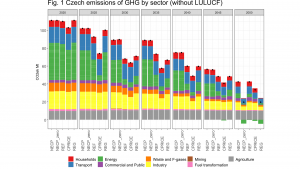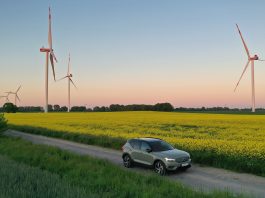The RegSim project develops integrated models for the analysis of the impacts of decarbonisation policies in Czechia.
The project ‘Integrated models for analysis of Regulatory impacts and Simulations of long-term scenarios of energy sector development’ (RegSim) used several integrated impact assessment models (partial-equilibrium energy market model TIMES, macro-econometric model E3ME, and hybrid CGE model) to analyse the impacts of decarbonisation policies and to stimulate long-term energy scenarios. The project provides the public administration, mainly to the Ministry of the Environment and the Ministry of Industry and Trade of the Czech Republic, with a scientifically-based quantification of the impacts of regulations and background material for the generation of medium- and long-term scenarios and trends in the energy sector, strategic planning, and policy formulation with the horizon of 2050.
European Green Deal
The European Green Deal aims to achieve climate neutrality by 2050 and sets a binding EU target of a 55% reduction in greenhouse gas (GHG) emissions by 2030 compared to 1990 levels. The Fit for 55 package that encompasses a suite of legislative initiatives across various sectors, which is intended to put the EU on track to deliver on its 2030 climate target of 55%, got close to its final approval during 2022. The initial impact assessment of the Climate Target Plan1 preceding Fit for 55 package has been followed by other studies focused on the EU Emissions Trading System (EU ETS) sectors only2 or on a share of GHG emission reduction between the EU ETS sectors and sectors under the Effort Sharing Regulation (ESR) and optimal GHG emission reduction in ESR sectors for each individual EU Member State.3
The European Green Deal and Czech climate neutrality assessment is one of the main outputs of the RegSim project.
We apply energy optimisation model TIMES-CZ 4,5 to analyse impacts of the extension of the EU ETS to buildings and road transport (EU ETS 2) and of a coal phase-out on the Czech energy system. We also assess the capability of Czechia to reach climate neutrality by 2050 without imports of biomass or hydrogen. We find that Czechia should be able to achieve 55% reduction in total GHG emissions in 2030, mainly due to GHG emission reductions in the EU ETS sectors. The effort needed to reach this target is lowered by the high GHG emissions level the base year 1990. Energy efficiency and renewable energy targets for 2030 are more difficult to achieve. Further decarbonisation is quite challenging and climate neutrality in 2050 cannot be reached without additional measures or higher imports of renewable energy.
National Energy and Climate Plan
The baseline scenario, called NECP, follows the National Energy and Climate Plan.6 Scenario REF follows the European Commission’s REF2020 scenario.7 Two policy scenarios (CPRICE and REG) include the EU ETS extended to buildings and transport sectors (EU ETS 2) and coal phase-out. While the REG scenario also aims to approach climate neutrality by 2050 conditional on these policies, NECP_zero scenario is searching for the optimal path to reach climate neutrality by 2050.
In all scenarios, demands for energy services and energy-intensive products are derived from the National Energy and Climate Plan.6 We conservatively assume Czechia is self-sufficient in all renewables and hydrogen production. The Dukovany nuclear power plant is decommissioned between 2036-37 in all scenarios. Scenarios NECP, NECP_zero and REG assume simple replacement of the Dukovany nuclear power plant with a new nuclear power source keeping the electricity production from nuclear constant. Installation of new nuclear sources is the result of cost optimisation in the TIMES-CZ model in the CPRICE scenario. The REF scenario is derived from the European Commission’s REF2020 scenario (EC REF2020), including nuclear power generation and net electricity imports.

A 55% reduction in total GHG emissions by 2030 is realistic for the small open economy, such as that of Czechia, mainly due to emission reductions in the EU ETS sectors. However, the pace of GHG emission reductions in the ESR sectors is slow in all scenarios, which is also due to the increasing demand for energy services. In 2030, GHG emissions in the ESR sectors are reduced by 15 (REG) to 22% (NECP and NECP_zero) compared to 2005.
In contrast, carbon neutrality is not achieved in any scenario by 2050, and 16 Mt CO2ek remains in the NECP_zero and REG scenarios even after accounting for emission sinks from land use, land use change and forestry (LULUCF), and carbon capture. There are several reasons for this, mainly related to modelling assumptions. First, all scenarios assume national self-sufficiency in renewables, hydrogen production and electricity generation; and the modelling results clearly show how limiting these assumptions are, especially for the decarbonisation of industry. Second, two sectors with non-negligible GHG emissions, agriculture and waste, are not directly modelled and the emission trajectories used for them are not in line with ambitious climate policies that will aim for a deeper uptake of circularity principles and waste hierarchy, progressive uptake of GHG mitigation practices in livestock and farming practices, as well as profound dietary changes in the population. Third, the assumed maximum potentials of solar and wind are rather conservative and can be overcome with the deployment of more advanced technologies and better co-ordination. Fourthly, the assumptions about the costs of emissions allowances and fossil fuels were made before the Russian aggression against Ukraine. All that followed, including full or partial embargoes on imports of coal, oil, and gas from Russia and a major shift to LNG imports, is likely to have a lasting impact on energy prices, energy policies, and consequently, entire energy systems.
Financial implications of decarbonisation
We also show that the costs of decarbonisation will be substantial, but there will be, which we have (partly) estimated, and vast benefits from climate change mitigation that are not included in the analysis. Savings and energy efficiency improvements are crucial to meeting emissions targets and, among other measures, the extension of the ETS to buildings and road transport is particularly relevant. The scale of the investment required is not only obscured by the fact that the bulk of the investment is in the renewal of the road vehicle fleet, which is largely routine. The other single investment item is the new nuclear power plant with estimate overnight costs of €13-20bn depending on installed capacity. This represents about one third of all investment in the electricity and heat generation sector in the baseline scenario (NECP).
If the investment decision is left to the cost optimisation algorithm, no new nuclear power plant is installed (CPRICE scenario) and electricity imports increase to almost 20%.
Acknowledgements
This research was funded by the Technology Agency of the Czech Republic under the THÉTA Programme, grant number TK01010119: “Integrated models for regulatory impact analysis and simulation of long-term scenarios of energy sector development” (RegSim).
References
- Commission Staff Working Document Impact Assessment Accompanying the Document Communication from the Commission to the European Parliament, the Council, the European Economic and Social Committee and the Committee of the Regions Stepping up Europe’s 2030 Climate Ambition Investing in a Climate-Neutral Future for the Benefit of Our People (2020)
- Pietzcker, R. C., Osorio, S. & Rodrigues, R. Tightening EU ETS targets in line with the European Green Deal: Impacts on the decarbonization of the EU power sector. Energy 293, 116914 (2021)
- Kattelmann, F. et al. How to Reach the New Green Deal Targets: Analysing the Necessary Burden Sharing within the EU Using a Multi-Model Approach. Energies 14, 7971 (2021)
- Rečka, L. & Ščasný, M. Impacts of Reclassified Brown Coal Reserves on the Energy System and Deep Decarbonisation Target in the Czech Republic. Energies 10, 1–27 (2017)
- Rečka, L. & Ščasný, M. Brown coal and nuclear energy deployment: Effects on fuel-mix, carbon targets, and external costs in the Czech Republic up to 2050. Fuel 216, 494–502 (2018)
- The National Energy and Climate Plan of the Czech Republic. (2019)
- Directorate-General for Climate Action (European Commission) et al. EU reference scenario 2020: energy, transport and GHG emissions: trends to 2050. (Publications Office of the European Union, 2021)
Please note, this article will also appear in the thirteenth edition of our quarterly publication.









